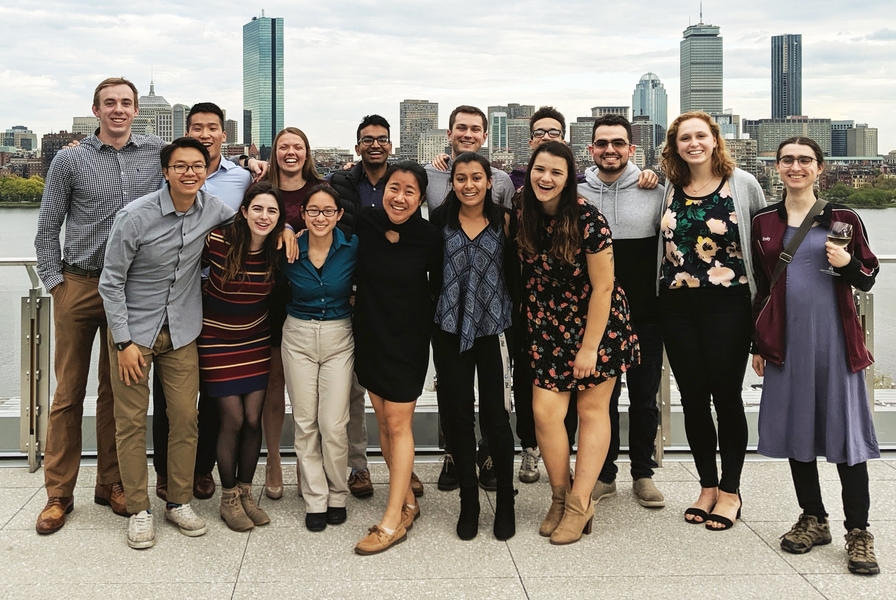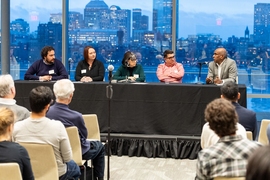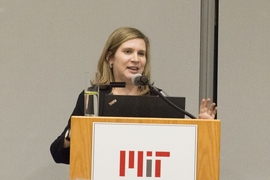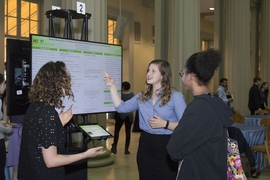The Department of Civil and Environmental Engineering gathered recently to acknowledge the close of the academic year and celebrate the Class of 2019 and notable members of the CEE community. The annual event unites students, postdocs, faculty, and staff and is a great evening to reflect on the accomplishments of the year and show appreciation for the people who make CEE an outstanding department.
The graduating seniors kicked off the event by presenting the findings of their capstone projects. The CEE capstone, a component of 1.013 (Senior Civil and Environmental Engineering Design), gives seniors the opportunity to work individually or in a pair in order to conduct engineering work with a real-world impact during the final semester of their MIT undergraduate career.
The design-focused work was presented in the form of digital posters, which allowed the community to interact with each student, or pair, to learn about their projects, and for CEE faculty to evaluate and vote on the top three posters. Topics ranged from tackling climate change issues and nature-inspired materials to data analysis of transportation systems and computational toolkits for green-space design. Markus Buehler, head of CEE and McAfee Professor of Engineering, announced that first place was awarded to Apisada "Ju" Chulakadabba, while Tim Roberts earned runner-up and David Wu came in third place.
Chulakadabba’s capstone project compared global climate models to the MIT regional climate model to examine projected climate-change impacts on hydrological cycles in China. The primary areas Chulakadabba focused on were the Yangtze River Basin, where the water supply is abundant, and the Yellow River Basin, where water is scarce. Her findings from the comparison provided the future trends of the hydrological processes in China, and also evaluated the performance of the selected models in the regions. Chulakadabba’s work suggests that there is an increase in annual precipitation, runoff, and evaporation trends; nevertheless, she emphasized that regardless of the potential increase in water availability, it is still important to have the Water Transfer Project as a backup plan. Chulakadabba stressed that based on her work, the project would be justified from an environmental engineering perspective. However, it is not financially sustainable.
Shifting from environmental engineering challenges to nature-inspired materials, Tim Roberts presented his project on synthetic silk production — a promising, yet challenging, design issue. The current method occurs in live cells and can take up to five days without yielding the desired results. His project focused on designing a screening process using cell-free protein expression to assess the feasibility of producing proteins in live cell expression.
Working with systems and data, David Wu's capstone project used data analysis to evaluate the effect that Red Sox baseball games have on congestion, specifically at the Kenmore MBTA stop in Boston. After games, there is a mass exodus of people attempting to utilize MBTA transportation, whereas at the beginning of games, fans' arrival times vary. Wu analyzed the MBTA data and examined how many people use the T to leave, and how travel times are affected. Using queuing theory and the given data, he created a queuing model to simulate station operations and estimate waiting times. Wu expressed that data is often limited, and it is beneficial to learn domain-specific concepts, such as queuing theory in terms of transportation, to gain invaluable insight that statistical models cannot provide, and to design more efficient transportation strategies.
Following the capstone poster session was the presentation of the CEE awards. All recipients were nominated by both peers and advisors for being exemplary members of the community who represent the CEE mission, and significantly contribute to the department’s excellence, cutting-edge research, and education. “The awardees resemble the aspirations, values, and ideals of the MIT CEE department, recognize exceptional achievements and talents, and inspire others,” Buehler said in his opening remarks.
The first portion of awards applauded undergraduates for their dedication to the department. This year, junior Zoe Lallas received the CEE Leadership and Community Award, which recognizes an undergraduate student who makes exemplary contributions to improve the CEE community, fosters excellence and diversity, and contributes to our inclusive culture. Lallas has served as the social chair for the CEE Student Association and has been involved with the First-Year Preorientation Program, serving as a mentor one year and a student organizer the next.
Sophomore Chelsea Watanabe won the Best Undergraduate Research Award, which honors excellence in any area of research by a CEE undergraduate student, carried out in the context of either an Undergraduate Research Opportunities Program internship or through coursework, such as Traveling Research Environmental Experiences. Watanabe is known to be inspiring to work with due to her deep sense of curiosity and ambitious attitude.
Senior Christine Langston won the Leo (Class of 1924) and Mary Grossman Award for her strong interest in transportation and impressive academic record. Langston has combined data from a variety of sources such as state and local transportation agencies, Google Maps, and Trip Advisor to measure and model travel patterns within cities. Langston is recognized for her passion and drive to improve transportation systems.
Senior Tim Roberts earned the Juan Jose Hermosilla (1957) Prize for demonstrating exceptional talent and potential for future contributions at the intersection of mechanics, materials, structures, and design. Roberts was nominated for being well-rounded and for his many achievements in engineering. He is not only proficient in Spanish and Chinese, but he also performed research at several labs at MIT and completed an internship at a leading structural engineering company. Roberts’ colleagues speak highly of him, as he is known to be very humble and thoughtful, willing to go out of his way to help others.
Senior Amber VanHemel was awarded the Paul Busch (1958) Prize, given to an undergraduate student in environmental science and engineering for academic achievement and contributions to the CEE community. VanHemel is recognized by her peers and professors as an exceptionally bright, hard-working, outgoing and ambitious scholar.
Achieving the Tucker-Voss award was MEng student Andrew Novillo, who completed his thesis in experimental testing of cast-metal connections for complex loading conditions designed with topology optimization. The award was established in memory of professors Ross R. Tucker and Walter C. Voss, who were the first two department heads of the now extinct Course 17 (Building Construction). When Course 17 merged with the Department of Civil Engineering in the 1950s, the Tucker-Voss award was established. Novillo earned this award for his use of innovative 3-D printing technology in his thesis, which demonstrated the promising future he will have in the field of building.
Graduate student Hayley Gadol was awarded the Trond Kaalstad (Class of 1957) Fellowship, which recognizes an outstanding graduate student who has displayed leadership and/or contributed significantly to the well-being of the CEE community. Hayley took on the goal of improving graduate student life in the department and the Institute, serving as the head of CEE Student Graduate Committee and taking charge of organizing events for the community.
The Maseeh Annual Award for Excellence, which recognizes the most outstanding teaching assistant in the past academic year, was awarded to Hejian (Patrick) Zhu, who was an instructor for the subjects 1.361 (Advanced Soil Mechanics) and 1.364 (Advanced Geotechnical Engineering). Through his commitment as a teaching assistant, Patrick has proved to be passionate about helping others deepen their knowledge and understanding of geomechancial topics.
Receiving the Best Doctoral Thesis Award was Simone Cenci, who worked under the guidance of his advisor, Mitsui Career Development Assistant Professor in Contemporary Technology Serguei Saavedra. This award honors scholarly and academic excellence and a high level of distinction of a CEE graduate student in any area of research. Cenci produced eight impressive research papers, and has significantly contributed to the area of theoretical ecology by expanding concepts and tools that can get us closer to a better understanding and prediction of population dynamics.
The CEE Postdoctoral Scholar Mentoring, Teaching and Excellence Award recognizes mentoring, teaching, and other exceptional contributions by a postdoc, emphasizing high potential for future contributions. Ehsan Haghighat received the award for his extraordinary teaching and generous mentorship, displaying strong research in computational mechanics and more. Ehsan excelled in this teaching role by demonstrating an outstanding ability to communicate knowledge effectively to the students, as well as earning top reviews in the student evaluations.
Two members of the CEE staff received the CEE Excellence Award, which recognizes staff for excellent contributions to the community, commitment to professionalism, dedication and best practices, and for fostering a culture of diversity, inclusiveness, and innovation. The first recipient was undergraduate academic assistant Sarah Smith. Smith was acknowledged for her ability to flawlessly handle every interaction with faculty and staff with a positive, respectful attitude and a smile.
The second recipient of the CEE Excellence Award was research engineer John MacFarlane. MacFarlane is known to be a dedicated member of the department who is willing to help others, ensure safety within labs, and maintain a great attitude. Buehler noted that MacFarlane is known as a “the Life Saver” by the students, faculty, and staff.
The department also presented faculty with three awards. The Samuel M. Seegal Prize, which honors faculty members for inspiring students to pursue and achieve excellence, was awarded to William E. Leonhard Professor Harry Hemond. The CEE community noticed Hemond for being a beloved teacher and mentor who leads by example, and who inspires students long after their time at MIT. A former student wrote in the nomination: “His mentorship shaped the scientist I am today, and I continuously strive to be as knowledgeable, thorough, and creative in my work as he is,” reflecting the great impact Hemond had on his students.
Associate Professor Lydia Bourouiba received the Ole Madsen Mentoring Award, which honors faculty members for conspicuous contributions to mentoring and educating CEE students outside the classroom, and inspiring them to pursue a career in the fields of civil and environmental engineering. Bourouiba teaches students the skills, qualities, and critical thinking required to succeed in their studies and research; more generally, she prepares them to be successful in their professional lives. One student wrote: “Her dedication and genuine care to the education, professional development, and well-being of her students and mentees are truly remarkable and extraordinary.”
Recognizing the most outstanding faculty member in the past academic year is the Maseeh Excellence in Teaching Award, which was presented to Esther and Harold E. Edgerton Career Development Assistant Professor Admir Masic. Masic stood out to his colleagues for his enthusiasm and energy for research that sparks the students’ interest in the challenge of learning. He is known by his students for his ability to make learning fun, engaging, and exciting.
“The CEE awards ceremony this year highlighted the extraordinary members of the department who contribute to our overall success, and gave the Class of 2019 an opportunity to showcase all of the hard work they have put into their capstone projects. This event exemplifies how various people in the department, from staff to the students and faculty, come together to continue fulfilling our commitment to excellence and solving important societal problems in infrastructure and environment,” Buehler says.












